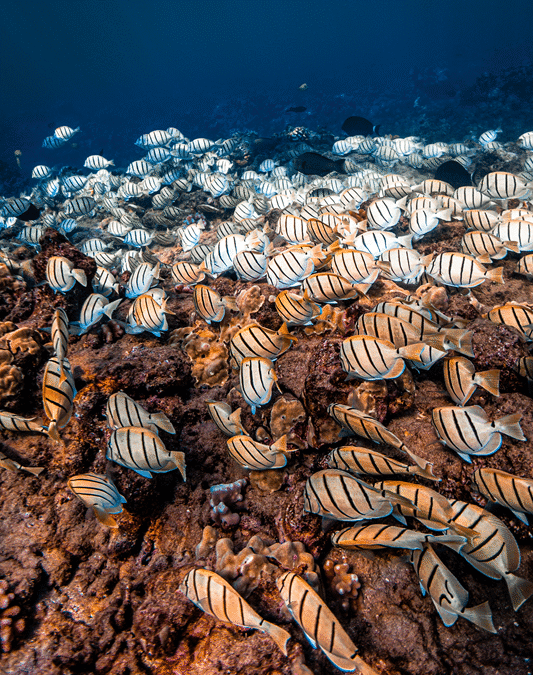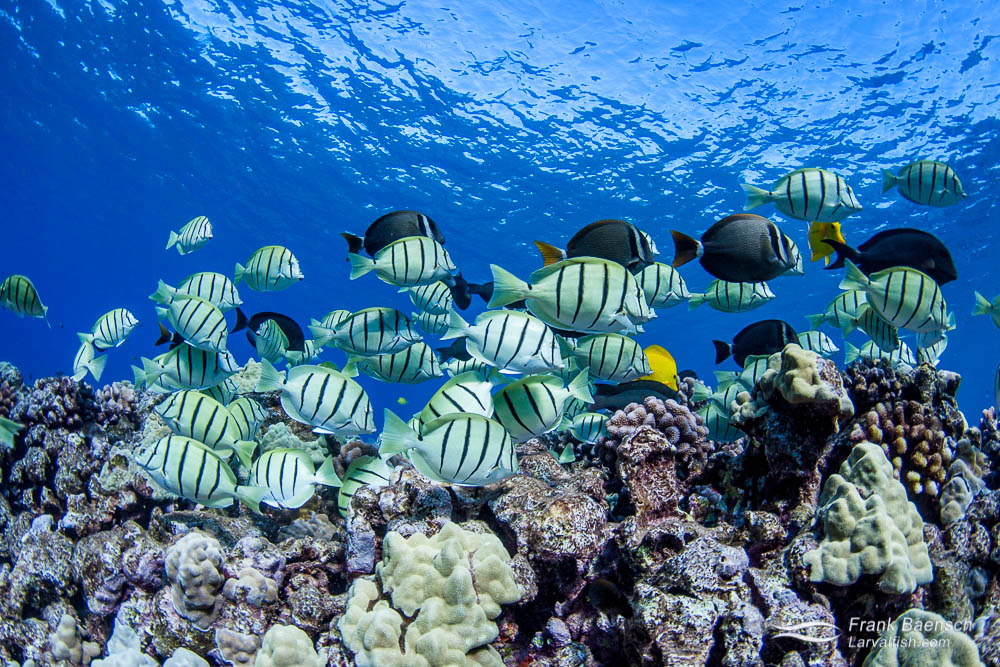If you’ve snorkeled in Oahu before, you’ve probably met a school of slim, striped fish zipping over the reef like tiny lawn mowers. Those are Convict Tangs, and they’re some of the most common, eye‑catching reef fish in Hawaiʻi. Locals call them manini. Visitors call them “the ones with the prison stripes.” Either way, they’re a joy to watch and easy to spot—perfect for new snorkelers and families!
In this guide, we’ll share how to identify Convict Tangs, where to see them on Oahu, what they eat, and the best ways to enjoy them without stressing the reef. We’ll also include simple tips so you can get clear photos and calm, close views on your next trip with Oahu Snorkeling.
Meet The Convict Tang
The Convict Tang is a member of the surgeonfish family. That name refers to the small, sharp spine near the tail—like a tiny scalpel. You will not notice it unless you get very close, which you shouldn’t. These fish are peaceful grazers and pose no threat to snorkelers.
Quick ID Checklist
-
- Oval, disc‑shaped body
- Pale silver or white base color
- Six bold, vertical black bars down the sides
- Small mouth for nibbling algae
- Usually 5–7 inches long (some grow bigger)
See a bunch of striped ovals moving together like a parade? That’s a school of manini. They often feed in groups, which makes them easy to find and fun to follow.
Why the Funny Name?
“Convict” comes from those bold stripes that look like old‑time jail uniforms. “Tang” is a common name for surgeonfish. The Hawaiian name manini is also used in local slang to describe something small or slight. Don’t let that fool you. These little fish play a big role in reef health.
Why Convict Tangs Matter
It’s simple: reefs need gardeners. Manini graze on turf algae that grows on rocks and coral. By snipping algae all day, they keep the reef clean and open for coral and other marine life. This steady grazing helps reefs stay healthy after big swell events and during warm seasons when algae can grow fast.
Watch a school of Convict Tangs for a few minutes. You’ll notice a pattern: glide, nibble, nibble, shuffle to the next spot, nibble again. It’s like a tiny lawn crew at work. Relax, float, and let their rhythm slow you down. It’s one of the most peaceful sights in the ocean.
One of the most fun things about snorkeling with these tangs is seeing them in big schools. Dozens—even hundreds—of manini can sweep across the reef like a living striped blanket.
Teamwork on the Reef
Manini love company. Feeding in a group lets many fish cover more ground while keeping an eye out for bigger fish. When a shadow passes, the school may scatter and then click back into formation. That quick burst is exciting to see, and it helps you understand how fish use teamwork to stay safe.
Swimming together helps them confuse predators.
A single fish is an easy snack. However, a group of stripes moving together makes it hard for bigger hunters to focus on one target.
What They Eat
Tangs are herbivores, so you won’t see them chasing after meaty foods. Instead, they nibble marine algae from rocks, coral skeletons, and hard sand patches. Their small mouths are perfect for this detail work. Because their diets are rich in algae, they play an important role in keeping reefs clean and balanced. No need to worry about bites—your granola bar is safe!
Ko Olina Ocean Adventures
Where to Spot Tangs in Oahu
The good news? These tangs are everywhere. If you’re snorkeling in Oahu, you’re almost guaranteed to spot them.
Top Snorkeling Spots
-
- Hanauma Bay Nature Reserve—This protected marine life conservation area is a hotspot for manini. Its calm waters and healthy reefs make it one of the best places to see schools of convict tangs grazing.
- Turtle Canyon (Waikiki Reefs) – Even in busy Waikiki, snorkelers can find manini schooling near coral heads just offshore.
- Shark’s Cove (North Shore) – In summer months, when the ocean is calm, Shark’s Cove teems with reef life, including plenty of tangs.
- Ko Olina Lagoons – These man-made lagoons are great for family snorkeling. You can often see Manini swimming in the calm, clear waters.
Shallow Reef Lovers
Convict surgeonfish like shallow, rocky areas where algae grows. This makes them especially visible to snorkelers, who don’t need to dive deep to enjoy their company.
Seasonal Notes
The South Shore is usually friendlier in winter. The North Shore is usually friendlier in summer. Conditions change day by day. Always check the forecast, ask a lifeguard, and pick a spot that matches your comfort and skill.
Photo Courtesy of Waikiki Aquarium
Why Snorkelers Love the Manini
They’re Everywhere
Unlike some fish that only appear in certain areas, manini are reliable companions. If you’re snorkeling in Oahu, chances are good you’ll see them on almost every outing.
They’re Gentle
Manini aren’t aggressive toward people. They will swim around you and go about their day. Sometimes, they come so close that you can see their small mouths eating algae from the reef.
They’re Photo-Ready
Because they travel in groups, convict tangs make fantastic photo subjects. Picture a wide view of many striped fish shining in the turquoise waters of Oahu. It’s a memory you’ll want to keep!
How to Watch Manini the Right Way
Good snorkeling is gentle snorkeling. The kinder you are to the reef, the closer the fish will come.
Easy Tips for Calm Encounters
-
- Float first. Let your body relax. Keep your fins and arms still.
- Move slowly. Use small, easy kicks. Avoid splashing your fins near the fish.
- Give space. Ten feet of distance keeps the fish at ease. Do not chase.
- Stay off the bottom. Never stand on coral. Sand plumes stress fish and cloud the water.
- Skip the snack time. Don’t feed fish. It harms their health and the reef.
- Wear reef‑safe sunscreen. Better yet, use a long‑sleeve rashguard.
- Bring a buddy. It’s safer and more fun.
Follow these steps, and you’ll be amazed at how close tangs will feed around you. You may even hear the soft “clicks” of their nibbling.
Hawaii Ocean Charters
The Science Behind the Stripes
Ever wonder why the manini’s stripes are so bold?
Camouflage and Confusion
The stripes break up their outline, making it harder for predators to single one out in a moving group. When you see a school swirling around, it’s easy to understand how effective this defense really is.
Reproduction Secrets
Convict tangs often spawn at dusk. During these events, they sometimes gather in massive groups. The males and females release eggs and sperm into the water column, creating a glittering cloud of new life. Their stripes may help them recognize each other during these frenzied moments.
Fun Facts
-
- They change tone. Manini can look paler or darker based on light, mood, and background.
- They’re reef cleaners. Their grazing limits algae and helps young coral settle.
- They’re tough. You’ll see them in shallow surge zones and calm lagoons.
- They love a crowd. Large schools make it safer to feed in the open.
- They’re widespread. These tangs live across the tropical Indo‑Pacific, not just Hawaiʻi.
- Small but mighty. Despite their small size, they can live up to 8 years in the wild.
Photo Courtesy of Frank Baensch
Book an Oahu Snorkeling Tour
Want to see Tangs? Book an Oahu Snorkeling Tour! Tour captains choose calm, clear spots so you can relax and enjoy the view. You’ll have quality gear, gentle entry, and friendly snorkel guides who share simple tips for safe, fun encounters. On Waikīkī trips, you’ll enjoy classic views of Diamond Head from the water while you float over busy reef life—often with manini right below you.
Tours are a great option for new snorkelers, families, and anyone who prefers expert support in the ocean. You’ll learn where to look, how to move, and what to watch for. That means more time with Manini and less time guessing.
Check out our tour filter page!
Wrap-Up: Your Striped Snorkeling Companions
The next time you dip below the surface in Oahu, keep your eyes peeled for the lively little Convict Tangs. From their bold black stripes to their playful schooling behavior, these fish are part of what makes snorkeling in Hawaii so magical.
Watching a cloud of manini sweep across a reef reminds us of the beauty and balance of ocean life. They may be small, but they play a huge role in keeping the reef healthy—and in giving snorkelers like you an experience to treasure.
So grab your mask, fins, and snorkel, head to one of Oahu’s amazing reefs, and meet the manini for yourself. Trust us—you’ll never forget your striped underwater friends.
See you on the water!




